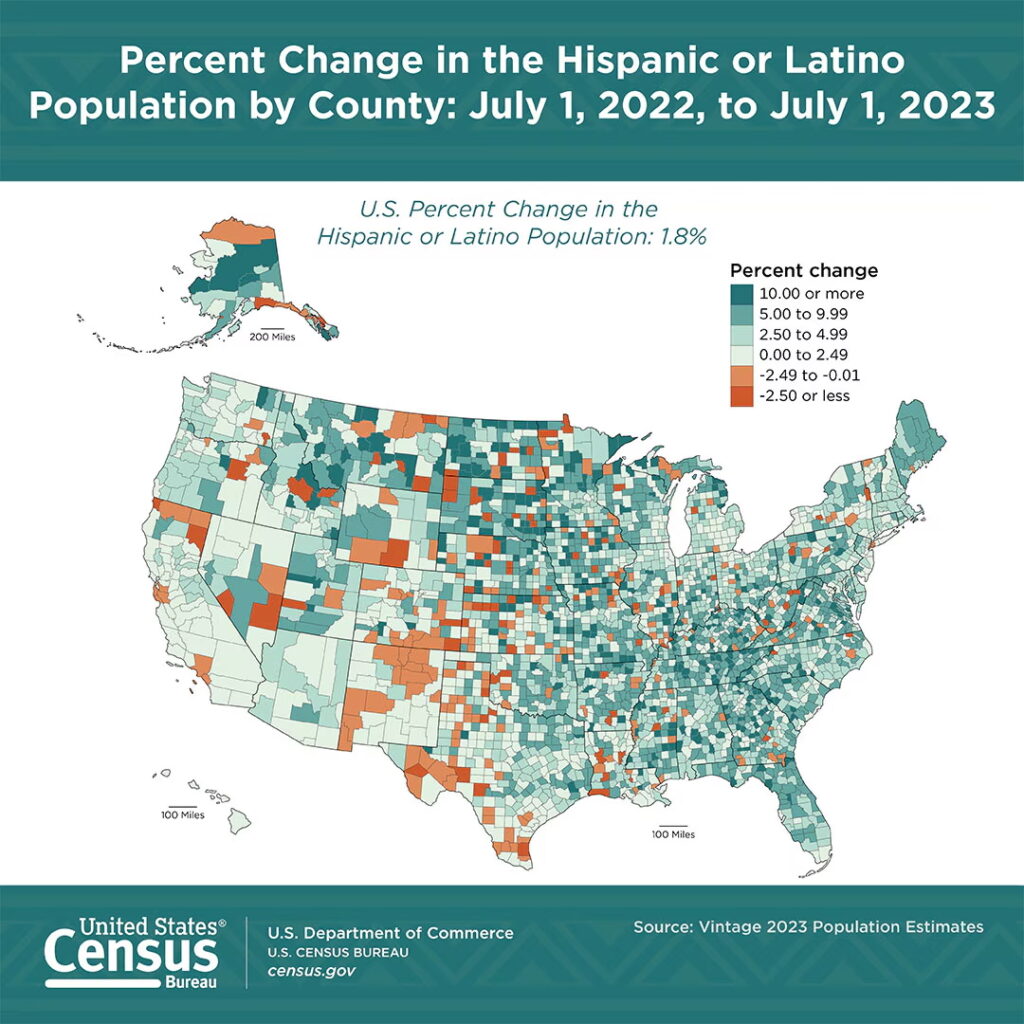
Reflections on the Dramatic Growth of Latin@s in the US
Watching news of ICE arrests and protests in Los Angeles, I cannot help but think how we have got here. The perception of many people who voted for President Trump is that there are too many “illegals” in this country. The reason for this impression, perhaps, is that the Latino presence in some states has increased exponentially in the last few decades. Towns with minimal or no Latino presence now have significant immigrants. The image below demonstrates this change in non-traditional Latino states, where the unprecedented growth has taken place.[i] According to the U.S. census bureau, between 2022 and 2023, the Hispanic population accounted for just under 71% of the overall growth of the United States population.[ii] Hispanics of any race grew to just over 65 million, an increase of 1.16 million (1.8%) from the prior year.[iii] This growth significantly contributed to the nation's total population gain of 1.64 million in 2023.[iv]

I live in the small town of Cleveland, TN. I remember first arriving in Cleveland when I was in the first grade. I have been in and out of Cleveland since I was six years old. Back in those days—and aside from my sister—I was the only “Hispanic” kid in the school. No one knew much about me except that I spoke Spanish and that I was learning English. I may not have been fluent in English, but I was good at learning things and came to the classroom with strong abilities. Though I did not have the language skills to keep up with my peers at the beginning, a particular instance let me know that I could do what my peers could do. I remember the teacher gave out a math worksheet on my first day of class that I finished before all my peers. I also got all my answers correct. Later, I steadily learned English and spoke it fluently within a year. In fact, I spoke English with a southern accent. One time, my parents recorded a greeting to send to my grandmother on a cassette tape. When I visited my native Honduras in the late 1990s, my sister and I found the exact cassette tape with the recording on it. When we listened to it after all those years, we laughed because we had a thick southern accent.
I am now in my 40s, and the school system has changed. There are many more children of Latin American descent, as well as other heritages. My son’s middle school has a lot of Hispanic students. He played soccer on his team with children whose parents were 1st generation immigrants of Argentine, Chilean, Dominican, Honduran, Guatemalan, and Mexican heritage (among many non-Latin American backgrounds, of course). He would sometimes come up to me and ask me questions about what certain Spanish words meant. Here I am, nearly forty years after I first arrived in Cleveland and things have changed in this small town. But even though all the children I have met here have arrived through the proper channels or are born U.S.-citizens, there is a strong anti-immigrant sentiment in my community.
This is xenophobia: the dislike of or prejudice against people from other countries. Just because a person is brown, it does not mean that they were or have been “illegal.” Seeing ICE arrest U.S. citizens even after providing proper ID is a clear sign of racial profiling by those who are supposed to keep us safe. Seeing the military deployed at protests is a politicization of the military. The way that these politics are working out makes me wonder if brown people will ever be perceived as true U.S. citizens and equal. The Latino community has increased exponentially. It is nothing to fear. And even if one day they were to become a majority in the U.S., like the case of Blacks in South Africa, it appears they would still be a minority in terms of economics and/or power.
I am a Christian and there are two important elements of faith that are important for us. The first is hospitality as a qualifier for leadership in the local church (1 Peter 4:9; 1 Timothy 3:2; Titus 1:8). I would also argue that it is a mark of a true Christian and a Spirit-filled life (Hebrews 13:2). The other element is compassion. If we remember the story of the Good Samaritan (Luke 10), good will and compassion extend beyond cultural, ethnic, racial, socio-economic, and nationalistic barriers. The radical nature of the Samaritan’s aid to the Hebrew man cannot be understated. The immigrant—whether legal or “illegal,” documented or undocumented—is our neighbor. We must now consider what it means for them to be our neighbor and what hospitality requires of us.
Notes & Bibliography
[i] US Census Bureau, “Percentage Change in the Hispanic or Latino Population by Country: July 1, 2022 to July 1, 2023,” https://www.census.gov/library/visualizations/2024/comm/hispanic-population-change.html, last accessed June 19, 2023.
[ii] US Census Bureau, “New Estimates Highlight Differences in Growth Between the U.S. Hispanic and Non-Hispanic Populations,“ June 27, 2024, https://www.census.gov/newsroom/press-releases/2024/population-estimates-characteristics.html (last accessed June 5, 2025).
[iii] Ibid.
[iv] Ibid.
Leave a Reply